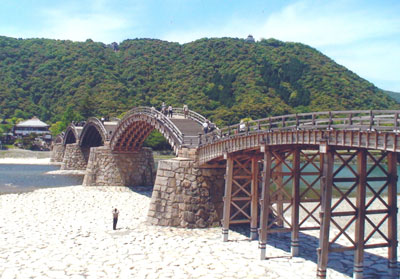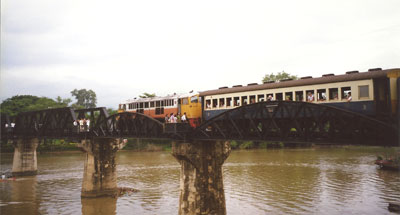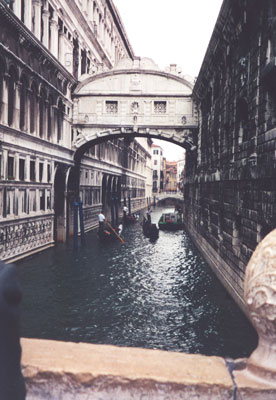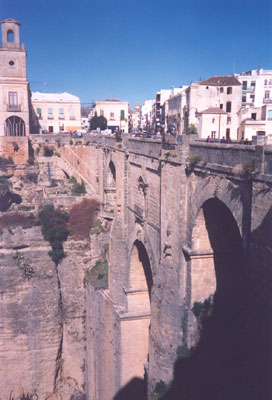Cross that bridge
We gave you this assignment: name a bridge (outside of the USA) that, for whatever reasons, is exciting to cross. Tell where it is (and, if necessary, how to find it) and approximately when you were there. Did you cross it on foot? By car? By train? Include your impressions. You may write about more than one bridge.
We printed a few responses (March, April & June ’10 issues). Here are a few more, with more to come. If you have one to add, write to Cross That Bridge, c/o ITN, 2116 28th St., Sacramento, CA 95818, or e-mail editor@intltravelnews.com (include the address at which you receive ITN). With photos, include captions.
When my husband, Bernie, and I were in Japan in May ’07, we used our Japan Rail Pass to travel independently the way we liked. As I was born and raised in Japan, there was no language problem.
One of our goals was to visit three of the most scenic sites in Japan, namely Matsushima, Amano-Hashidate and Miyajima. Near Miyajima, there is a famous bridge in Iwakuni called Kintai Bashi, or Bridge of the Brocade Sash.
We took the Sanyo Honsen bullet train (which travels between Osaka and Shimonoseki to the west) and got off at Iwakuni station, then took a city bus to the bridge. (The city bus makes a circle, and all visitors need to do is mention “Kintai Bashi” to the driver.)
The feudal lord who governed this area had a beautiful castle on top of the mountain and built Kintai Bashi to cross the river to Iwakuni. This river could have high water and be treacherous at times, so he had the 209-yard, five-arched wooden bridge built high above the water level. (The original bridge, built in 1673, was destroyed in the Kezia Typhoon of 1950; a replica, built in 1953, is in place today.)
We went down to the riverbed to look up at the bridge from underneath. At that time, the water level was quite low and the riverbed had become a massive parking lot, with at least 15 tourist buses parked there.
Across the bridge from Iwakuni, the castle grounds are beautifully laid out with trees, historic buildings, etc. It was a peaceful place to spend an afternoon.
Miyako Storch
Santa Barbara, CA
For many reasons, my most memorable bridge and bridge crossing is that of “The Bridge on the River Kwai” in Kanchanaburi, Thailand. My love for Southeast Asia in general and for Thailand in particular has probably prejudiced my selection, but this bridge crossing must truly be a moving experience for anyone.
The bridge that remains in this location is, in part, a third rendition of the infamous bridge fictionalized in the movie. Reality was much worse.
The first bridge was wooden and was completed by the forced labor of Thai citizens as well as POWs, mostly British and Australian and some American. The wooden bridge was finished in February 1943 a few hundred fee away from the current bridge.
Later in 1943, the Japanese transported a steel bridge in sections from Java and had it placed by forced labor in the present location. Toward the end of the war, the middle section of that bridge was destroyed by Allied bombers.
After the war, the destroyed section of the bridge was rebuilt. The sections with the rounded guardrails are the original and the rectangular sections are the rebuilt ones.
So much suffering in this region is represented by this simple, homely bridge. It is fitting that the reconstructed bridge survives as a monument to the POWs and to the Thai laborers, who are often overlooked in this tragedy of WWII.
My husband and I visited Kanchanaburi in November 1998. We walked across the bridge and also took an excursion train across it and into some of the most notorious areas of the railroad construction. At that time, the excursion train cars were built of wood and made to resemble the original trains of the 1940s era.
The train trip was all the more memorable because a group of charming Thai high-school-age students used the time on the train to practice their English with us.
Barbara McMahon
Bethesda, MD
After traveling to more than 60 foreign destinations, I must say my favorite place to visit is Venice, which I’ve been to four times, most recently in 2007.
What symbolizes Venice, for me, is the Bridge of Sighs (Ponte dei Sospiri). It is named for the prisoners who supposedly “sighed” when passing from the Inquisitors’ rooms in the Doge’s Palace (left side of photo) to the prison (right side).
Nancy Hesselbrock
Cincinnati, OH
The most exciting bridge I ever crossed was a 100-foot-long bridge made entirely of dried grass! It spans the gorge of the Rio Apurímac near Huinchiri, Peru, 60 feet above the river. Over four days each June, Inca descendants rebuild the Keshwa Chaca, the grass bridge, to keep the ancient tradition alive.
Village women twist three-foot lengths of dried, slender qqoya, an Andean bunchgrass, into long ropes. These are plied into cables 10 to 12 inches in diameter, which are hauled into place, with much effort, by men on either side of the river.
Smaller handrail cables are added, even smaller cables are added enclosing the sides, sticks are woven across to make a base and, finally, mats of sticks and grass are unrolled to make the floor.
In June ’08 I was honored to be the very first woman ever to sponsor the bridge, so, as La Madrina del Puente (The Godmother of the Bridge), I was the first person to cross the new bridge after the village elders. (It also meant I was first to produce the obligatory $30.)
With heart pounding, and keenly aware of all the watching eyes, I found the rhythm of the swinging bridge and trod steadily onward until I arrived within six feet of the far side and found cables only, no floor! The elders, going before me, had apparently failed to note this omission.
I hesitated, then gingerly walked on the exposed cables, then turned and made my way back, to much applause.
Sheila Monk
Richland, MO
Several years ago my wife and I were driving in the Andalucía region of southern Spain when we came across the town of Ronda. Ronda was first settled by the Celts and has been conquered by the Sueves, the Byzantines and, of course, the Moors, who would rule the area from 711 to 1485.
The town is divided in two by a huge gorge, El Tajo. This fabulous natural wonder has been carved out of the limestone by the Guadalevin River. One side is the city’s old quarter, La Ciudad, which contains many architectural treasures. On the other side is the Plaza de España, where the mercantile area is situated as well as the oldest bullfighting ring in Spain.
There have been a couple of bridges built over the gorge. Philip V ordered the first bridge, built in seven months starting in 1735, which collapsed in 1741. In 1751 the current bridge, the Puente Nuevo (New Bridge), was started, but it took until 1793 to complete it.
The 98-meter-tall bridge rests on rocks, putting it at a maximum height of 120 meters above the gorge floor.
If you go to Ronda, take a few minutes to take in the impressive view from both ends of the bridge. You will have many lasting memories.
Theodore Lewis
Severna Park, MD





